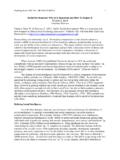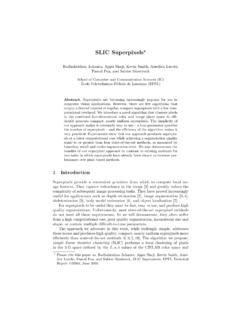Transcription of © Copyright 1999 by Roger Altman
1 Copyright 1999 by Roger Altman COLLOIDAL SILVER: WHERE DOES IT GO WHEN YOU DRINK IT? HOW LONG DOES IT STAY THERE? Disclaimer This report is for informational purposes only. It is not meant to be a personal guide for colloidal silver dosing. The results are based on a single individual s metabolism and excretion rate, which vary widely from person to person. Summary A fixed amount of colloidal silver was ingested each day for several months before a preliminary 24-hour silver balance was attempted by measuring the amount of silver found in feces, urine, nails, hair and perspiration. After estimating the amount of silver produced in 24 hours from each of these sources, it was concluded that urine and feces provide a good first approximation of the total amount of silver excreted by the body. This study was followed by a second more extensive effort which was designed to monitor the residual quantity of silver eliminated over time by estimating the weight of silver in feces and urine from weekly (and later, tri-weekly) 24 hr.
2 Samples. During this period, a single test was made in an attempt to demonstrate the influence of water intake on the quantity of silver excreted in urine. Introduction Despite the recent popularity of using colloidal silver (CS) for water purification and to treat infection, there exists no reliable data with respect to silver elimination rate from the body including its distribution in feces and urine. Thus, I decided to measure my own colloidal silver intake and elimination rate as well as to investigate silver accumulation in specific areas of the body, such as hair, fingernails and perspiration. I also made a single measurement to survey the effect excess water intake has on the amount of silver eliminated in urine. This report represents the first attempt to answer these questions. Hopefully, these initial results may serve as a first step in establishing safe and effective dosages for using CS therapeutically, or even prophylactically. One of the historic stumbling blocks that has made it difficult to accurately estimate silver elimination and distribution in the body has been due to the haphazard substitution of silver salts for CS, or the poor quality of CS produced for experimentation.
3 For decades, grinding and precipitation were the only methods available. While some of these crude techniques did produce some CS, the product itself, nor its concentration, could be relied upon to be consistent from batch to batch, or to contain enough small particles to have much biological activity (while minimizing the dangers of heavy metal poisoning). Recently, the electrolytic method has gained popularity, but even this method can produce a broad range of results due to wide variations of colloid particle size and concentration. Copyright 1999 by Roger Altman 2 For a number of years, the most common electrolytic method has relied on wiring batteries in series so that two ( pure) silver electrodes could generate a potential of about 27-36 volts between them. To help promote the reaction, some vendors have recommended adding a small amount of salt to the distilled water electrolyte, while others believe that bonding the CS to a soluble protein would help stabilize the colloid, and thus allow it to better maintain its potency.
4 Whatever the proposed fix , these low voltage electrolytic generators yield CS that is unsuitable for research purposes because its potency is inconsistent from batch to batch, in addition to the fact that the CS is generally of poor quality based on impractically low silver concentrations, and/or an unacceptably large particle size. All of these variables contribute to forming a product, which has an unpredictable, and generally low biological activity. However, these problems can be overcome to a great extent by using a power supply with a 180 volt DC output and 120 AC input. Set-Up The present study is based on using a 180-volt DC current between a stainless steel container (cathode) and a silver strip (anode) suspended in about a half gallon of distilled water (less than 2 ppm total dissolved solids). The water distiller, as well as the electrolytic set-up and power supply, were commercial units purchased through the Internet. A milliammeter was added to the circuit to measure current to both monitor and help achieve process reproducibility.
5 Preliminary Study A 24-hour silver balance was recorded by noting the total amount of CS ingested during this period and then analyzing urine and feces in order to measure the amount of silver excreted via these two modes (Kimball Labs, Draper, Utah). In addition, the amount of silver contained in perspiration, hair and nails was also determined. The results (given in mg) are summarized below. 24 HOUR SILVER BALANCE (mg) Silver In Silver Out Ingested: urine: feces: hair: perspiration: nails: Total Copyright 1999 by Roger Altman 3 For purposes of a mass balance, the amount of silver in hair, perspiration, and nail samples cannot easily be transformed into a corresponding 24-hour equivalent, but judging from the low level of total silver present from these sources, I think it is reasonable to discount these avenues for significant silver elimination.
6 Taking into account silver loss through feces and urine alone, this preliminary study reveals that: 1) Silver is excreted easily from the body, primarily in the urine. 2) More silver leaving the body than entering during a 24-hour test period probably can be accounted for by the variability of the total amount of urine and feces produced on a day to day basis, , body tissue acts as a flywheel retaining and excreting more or less silver depending on the daily volume of bodily waste generated. 3) Since the same daily amount of silver had been taken for several months prior to this 24 hour test, it is reasonable to conclude that the total amount of silver residing in body tissue is many times that of the daily amount eliminated (this conclusion is supported by additional evidence given later). Therefore, it seems quite possible that CS taken prophylactically offers better protection than CS taken only at the onset of illness. Primary Study Procedure The procedure used to monitor the silver elimination rate had these steps: 1) CS was consumed daily for several months and ranged from ingesting less than 1 mg (during the first month) up to mg per day (for most of the study).
7 2) After approximately 5 months of daily CS ingestion, no further CS was consumed, and the total CS ingested was estimated by analyzing the electrolytically generated CS for silver and noting the daily volume consumed. 3) The first fecal and urine sample was collected 5 days after CS ingestion ceased. After that , samples were collected weekly during a 24 hour period up to and including the fifth week. Beyond that point, 24-hour sampling occurred once every three weeks. The weight of feces and the volume of urine were noted for each 24-hour collection period. Then about 50 grams of feces and 50 ml of urine were sampled from the total amount collected and sent to the lab (Kimbal Labs, Draper, Utah) for silver analysis. Results were reported in ppm for the urine samples and in mg of silver per measured fecal weight (containing the original amount of moisture). Total silver in feces was then calculated from the ratio of total collected weight divided by the weight reported by the lab.
8 Total milligrams of silver in urine were obtained by multiplying ppm reported by the lab by the total urine volume taken during the corresponding 24-hour period. 4) Because of the day-to-day variation in the volume of urine and feces, milligrams of silver in a given sample were normalized to a daily average urine volume and fecal weight using the equations and values shown below: Copyright 1999 by Roger Altman 4 Adjustment of 24-Hour Urine and Fecal Samples Feces: [standardized mg silver] = CF x mg silver in individual fecal sample Where CF = avg wt for fecal samples (503 grams)/wt of an individual fecal sample Urine: [standardized mg silver] = CU x mg silver in individual urine sample Where CU = avg vol for urine samples (1648 ml)/vol of an individual urine sample The raw as well as the adjusted data are summarized in Table I. Estimating the Rate of Silver Elimination As the body is depleted in silver, the rate of its elimination slows down.
9 A graph illustrating this relationship would show milligrams of silver excreted approaching zero asymptotically as time approaches infinity. Since I have a very limited number of data points, this graphical relationship would require fitting a curvilinear relationship with time (x) axis, which would increase uncertainty. Accuracy can be improved by plotting the reciprocal of total milligrams of silver eliminated per day because this function creates an approximately linear relationship for most of the data. Even though there is little doubt that some residual silver remained in my body after 96 days (when the last sample was taken), I have chosen not to extrapolate the reciprocal of mg silver eliminated per day to infinite time because doing so would only add another element of uncertainty. Therefore, the percent silver elimination discussed below should be viewed as a maximum value, which can be refined when more data becomes available. Figure 1 shows a plot of silver elimination rates given in the last column of Table I.
10 Note these values, which are the reciprocal of the normalized data, appear linear over an appreciable time period (between 19 and 96 days). However, the data point for the 19th day required a very large correction in urine volume to standardize it to the nominal (1648 ml) value. Therefore, it may be more prudent to assume linearity only between day 33 and day 96. In addition, the data including the 12th and 33rd day appear to exhibit a constant silver elimination rate, whereas the data including the 5th and the 12th day appear to be linearly related to time. No doubt, the scarcity of precise data in the 0-33 day timeframe create uncertainty with regard to the exact relationship between silver elimination rates and time during the first few weeks of sampling. Nevertheless, I believe there is some justification to characterize these data as points lying on three distinct curves. Supporting this hypothesis is the changing distribution of silver between urine and feces as a function of the silver concentration in body tissue.








